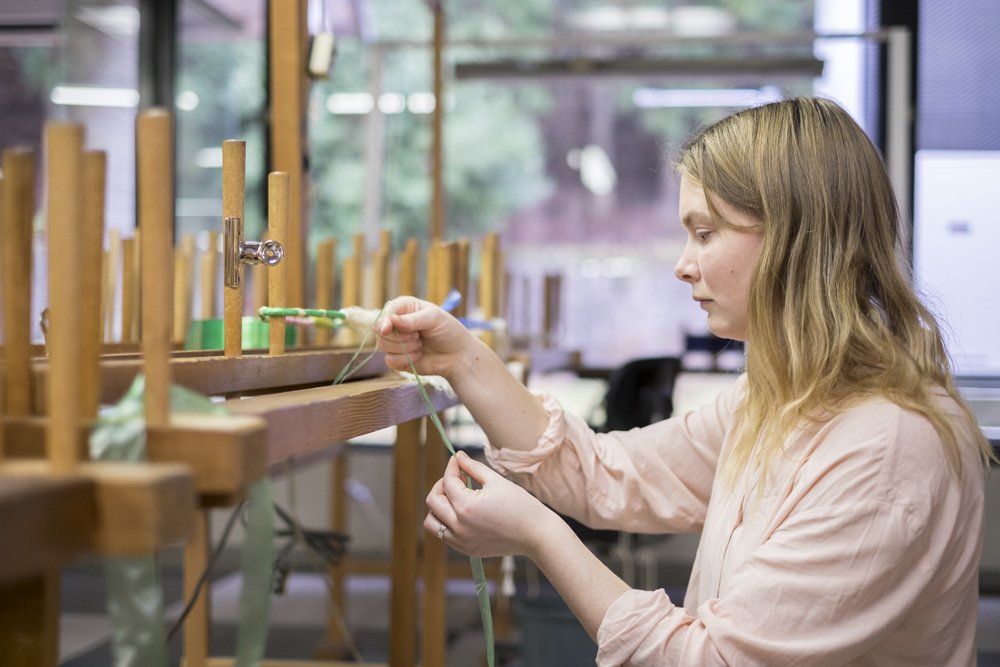This is a series that covers the classes of skilled dyeing expert Masaru Hori-sensei, and looks at the “something” we must value. In the final part of this series, we covered the dyeing process for making a kimono, which one of the second year students is working on. In the process of creating a weaving project, thread dyeing, which is done in the beginning, is the key part. It is no exaggeration to say that the finished piece is determined by the colors that are produced, and it is a great relief for students to be able to consult with an expert. To dye the silk thread needed to weave a kimono, students receive one-on-one guidance from Hori-sensei, starting from how to prepare the thread, how to handle it, test-dyeing, dyeing, to finishing.
This video is a scene from “scouring.“ This step is to remove contaminants attached to natural fibers, and in the case of raw silk, the purpose is to remove a paste-like component called sericin that covers the surface to reveal the original luster and texture of the silk. The warp thread was scoured for about 40 to 50 minutes this day. Hori-sensei says that removing sericin slowly over time is "the trick to keeping the luster and moistness unique to silk," and first, demonstrates the movements. Hori-sensei handles the thread smoothly and quickly. Techniques to keep the thread from getting tangled can be observed at every turn, and the repetition of the movements create a good sense of timing and rhythm. However, this is difficult for inexperienced students, especially since silk thread is delicate and can get tangled easily, so handling it requires special attention.
Dyeing is carried out in steps, from the warp, the weft, and the Kasuri thread. The day the warp Kasuri thread was to be dyed, the student brought over a thousand of them, holding them in her arms dearly. She had spent several weeks binding the thread, and was fully prepared for this day. It is rare that a student would dye this much Kasuri, and Hori-sensei says, “I am still learning.” Hori-sensei is an expert who has been teaching at the school for over 20 years, on top of his foundation of 42 years working as a dyeing craftsperson. Even so, he always starts by thinking from the same point of view as the student, and faces dyeing with fresh eyes.
While the work of binding Kasuri thread is steady and time-consuming, the actual dyeing is a one-shot game. The student had already discussed what kind of dye to use and how to dye the thread with Hori-sensei, and had pre-mordanted the thread prior to this day. "Natural dyeing is difficult because it's hard to get the color you want," Hori-sensei reminds her. The thread will be dyed purple, green, and yellow-green. When test-dyeing, the student used purple gromwell for purple, green leaf extract for green, and kariyasu for shifting that to yellow-green. However, in the actual dyeing, the green color does not appear, and unexpectedly turns out to be yellow-green from the beginning. Hori-sensei quickly suggests, "Let’s add indigo." Then, while adjusting the amount of dye and hot water, gives advice on how to match the color to what the student wants.
As the dyeing progresses, the thread is taken outside to have the color checked under the sunlight. Both Hori-sensei and the student’s expressions as they face the color are serious. “How is it?” “A bit more.” The student dyes again, and takes notes on what and how much dye is added. Discussions on color matching continue that way, the student repeating “a bit more,” again and again. The moment the tone of her voice went up, saying, “It became a good color, Sensei!” Hori-sensei, who checked the color, broke into a smile. Hori-sensei said, "Why don’t we dye it one last time." After finishing, the student said, "It became the color that I wanted," looking relieved. “It’s difficult to get the right balance when it’s really close. Sensei’s advice is very helpful then.”
In this series, we joined Hori-sensei’s dyeing class and looked for the "something important" from the way he taught. We have introduced an aspect of the school, where students can learn dyeing broadly and deeply, such as understanding why data samples are necessary, Kanzome, where perfect color matching is the starting point, basic movements to avoid tangling the yarn, and how to handle yarn.
"I can't stay that long (in terms of age), but I have to stay a little longer,” Hori-sensei calmly says, as there are many students who look up to him and seek advice. His fundamental wish is that students “come to like dyeing, and continue." I thought that the "important something" goes back to the simplicity of this wish. This was because it was unwavering, and showed in his attitude when interacting with students in all of his classes.
Hori-sensei will continue to walk closely alongside his students again next year.







